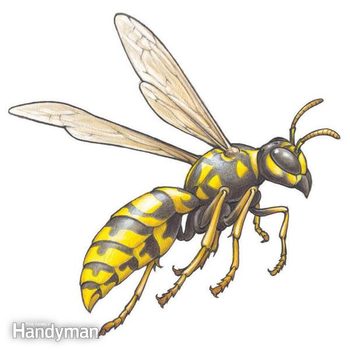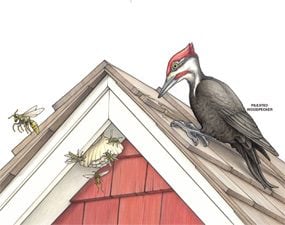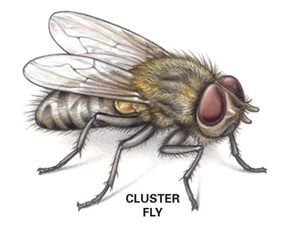Get Rid of Wasps, Woodpeckers and Flies
Updated: Feb. 07, 2023Stop common pest invasions of your home.

Wasps
Wasps are one pest just about every homeowner has to deal with sooner or later. The magic bullet for getting rid of wasps (yellow jackets) and bees is to destroy their nest. This is easier said than done. Bees and wasps are notorious for hiding their nests inside walls or high under shingles and eaves, where they’re difficult to get at.
The trick to finding the nest is to observe their movements closely. You’ll soon spot where they zoom into the wall of your house. Once you locate the nest, spray it with an insecticide that’s formulated for killing bees and wasps. Pick one up at a hardware store or nursery. The best time to spray is at night when the bees are less active and inside the nest.
Be aware that these insects can be extremely aggressive, especially when their home is under attack. Some can sting repeatedly, and those stings can cause severe reactions if you’re allergic. If you’re on a ladder or on the roof, the last thing you want is an angry storm of bees coming after you!
In difficult situations, have the nest professionally removed. If you decide to spray the nest yourself, make sure to wear protective clothing, including face protection, to guard against stings.
Woodpeckers
Woodpeckers can attack wooden shingles on a house for no apparent reason. Left unchecked, they will soon put a hole in your roof or siding. The first thing to know is what you can’t do. The Federal Migratory Bird Treaty Act, as well as some state laws, protects woodpeckers, which means it’s unlawful to harm them. (So don’t go for the pellet gun!)
The woodpeckers are making holes in your shingles because either they’re looking for food, or more likely, “drumming” to mark their territory. Unfortunately, there’s no simple way to get rid of them. Your best option is to harass the birds into leaving.
First, fasten sheet metal over the areas the birds are pecking. Also hang mirrors and Mylar tape nearby, for example, from the fascia (or tuck it under the next row of shingles). Shiny lights and reflections sometimes scare woodpeckers away, as do owl decoys. Frankly, however, these remedies don’t always work, and the longer the woodpeckers have been at your house, the harder it will be to get them to leave.
To further harass the birds, shoo them away with a broom. If you’re persistent, the birds will eventually move on.
Flies
The fall is when flies will congregate swarm around the upper windows of your house where the sun is strongest. They are not looking for something to eat, just a warm place to spend the winter. The good news is the flies probably aren’t attracted to a dead animal in your house. If they were, they would disappear after a few days. You probably have cluster flies. They’re about 5/16 in. long and have yellow hairs on their abdomens.
Cluster flies, also known as attic flies, are attracted to light and warmth. They gravitate to second-floor windows, which are usually the warmest spots in the house. The flies breed outside in the ground during late spring and early summer and have a life span of 27 to 39 days. In the fall, they find a way indoors through small cracks around doors, windows, soffits and siding. Try this DIY TikTok famous fruit fly hack to get rid of them.
The best time to stop cluster flies is before they come indoors. Caulk cracks around the foundation, siding, exterior trim and other potential entry points. Replace weather stripping as necessary to seal around doors and windows. If that doesn’t work, spray an insecticide formulated for flies around the outside of your doors and windows, soffits, eaves and cracks in the siding.
If large numbers still come in, an insecticide suitable for use indoors is the only effective way to eradicate them. Or call a professional exterminator to handle the problem.



